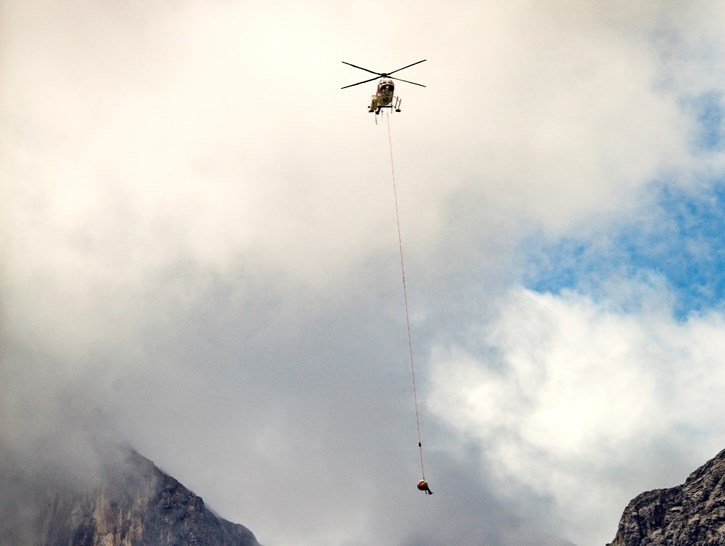No mountain in Kananaskis Country saw more rescues than Yamnuska in 2017.
Of the 350 calls Kananaskis Public Safety received in 2017, 33 came from those stranded on the slopes of Mount Yamnuska (officially named Mount John Laurie), and the numbers have risen steadily over the past three years. Now, the province is taking measures to make the mountain safer.
According to Kananaskis Public Safety Officer Jeremy Mackenzie, efforts are made every year to mitigate the number of rescues on the flat-faced mountain, and this year will be no different. Blue arrows were added to scramble routes and large warning photos were posted at the trailhead, illustrating the crux of the climb. But the mountain’s popularity among scramblers, hiker and climbers has resulted in more rescues.
“Different mitigations have been tried. It does seem to help, but then it transfers the problem to somewhere else on the mountain,” Mackenzie said. “Generally speaking, there are definitely more things going on.”
In 2015, Kananaskis Public Safety had 25 responses on Mount Yamnuska. That number hit 28 in 2016, and is at 32 to date in 2017. A response includes anything ranging from a climbing rescue to an injured scrambler or lost hiker.
“The area is super-popular. The pure volume there means we’re definitely exposed to the broad spectrum of experience levels, and that’s contributing to the numbers,” Mackenzie said.
Most rescues on the mountain involve hikers from Calgary with bad trail information. On a positive note, most hikers carry smartphones, which allows KPS to talk them to safety, as opposed to initiating a search and rescue operation.
“When we look at the stats, the vast majority of people we rescue are from Calgary. For the majority, those rescues would not involve a helicopter. It seems we don’t fly a ton of people off Yamnuska. We have done a lot of hiking folks out,” Mackenzie said.
The hike is popular on outdoor websites and social media, thanks to its striking nature. There are at least 10,000 posts on Instagram alone of the mountain. Since the official trail only goes to the shoulder of the climb, Alberta Parks does not include a description of the full route on its website. Others have tried to fill the void.
“We battle so many online postings that are inconsistent. Some say it’s difficult and hard. Others say it is easy. We run into that a fair amount. Some haven’t got good information,” Mackenzie said.
Due to the increase in rescue volume, Kananaskis Public Safety has hired an additional staff member, yet conservation officer numbers have remained the same. Mackenzie said the effort to reduce the number of rescues on the mountain is a primary concern, as a busy weekend can see KPS respond to 18 calls.
“It’s certainly on our radar because of the effort, time and money put into it. Rescues on Yamnuska take resources away from other issues,” Mackenzie said.
Alberta Parks doesn’t track the number of visitors on Yamnuska, but anecdotally, Mackenzie said its one of the most popular trails, often with a jammed parking lot on weekends.
Improved signage and trail maintenance is planned for the scrambling route, which includes 900 metres of elevation gain, steep scree sections and an infamous exposed section. Yet some issues which plague Yamnuska, such as unclear signage, braided trails, and inconsistent information, are also seen elsewhere.
Grotto Mountain and East End of Rundle have seen more rescues this year, while emergency calls on Ha Ling, Lady MacDonald and Heart Mountain are down. Many Bow Valley hikes are not official trails, and don’t have clear trailheads, which can create problems for rescuers.
Retired trail builder Don Gardner said most trails in the Bow Valley are in poor shape. He helped design the trail system at the Canmore Nordic Centre, and Kananaskis Country, and said the Bow Valley didn’t get the same design plan, due to the amount of private property involved.
“The reason we have such shoddy hiking trails in this valley – and they are just atrocious with no parking, and no trailheads – is Kananaskis area planning didn’t carry over into the Bow Valley. There were so many private property issues,” Gardner said.
A lack of funding is also inhibiting trail work, Gardner believes.
“There is not the funding we had in the ‘70s and ‘80s. There is not enough money to deal with the resurgence of hiking,” Gardner said. “We need more education. We already see enough signs. The message needs to get out there … of the dangers.”
The problem isn’t isolated to the Bow Valley. Colorado saw 11 mountain fatalities this summer, prompting officials to launch a new Peak Awareness program to educate outdoor enthusiasts.
Gardner said extremely fit volunteers built many local trails. But they didn’t build trails with others in mind, nor do they build with drainage in mind. He’d like to see more well graded trails, as seen in Banff National Park.
In the meantime, Kananaskis Public Safety will continue to see 10 per cent of its rescues take place on Yamnuska.




